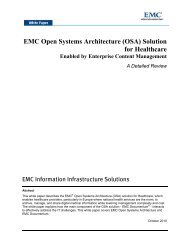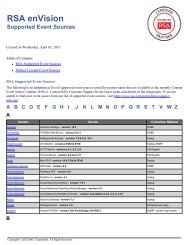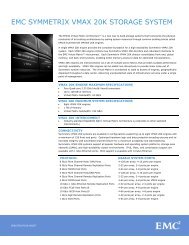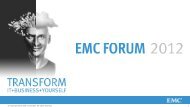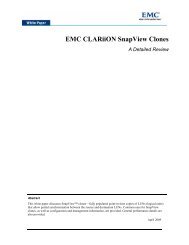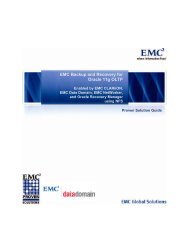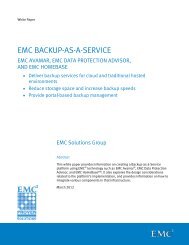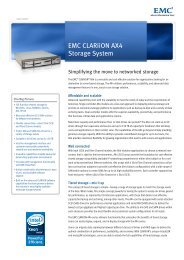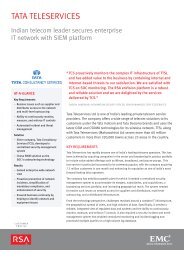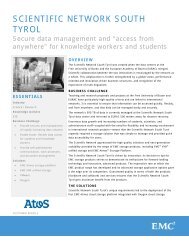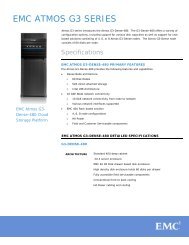Despar: Accounts payable invoice processing time cut by ... - EMC
Despar: Accounts payable invoice processing time cut by ... - EMC
Despar: Accounts payable invoice processing time cut by ... - EMC
Create successful ePaper yourself
Turn your PDF publications into a flip-book with our unique Google optimized e-Paper software.
CUSTOMER PROFILE<br />
<strong>Despar</strong>: <strong>Accounts</strong> <strong>payable</strong><br />
<strong>invoice</strong> <strong>processing</strong> <strong>time</strong> <strong>cut</strong><br />
<strong>by</strong> more than 50%<br />
The <strong>EMC</strong> Captiva solution is the basis for the new accounts <strong>payable</strong><br />
<strong>invoice</strong> management process operated <strong>by</strong> Aspiag Service, a <strong>Despar</strong><br />
group company. It ensures speedier <strong>processing</strong>, optimal use of<br />
resources, economic advantages, quicker and simpler problem<br />
identification and solving, and better cooperation and interaction<br />
between company departments.<br />
Spar International began as <strong>Despar</strong> in Holland in 1932, a consortium of wholesalers and independent<br />
retailers whose aim was to compete with the food store chains that were springing up throughout<br />
Europe. Today it is the world’s biggest retail food chain, with in excess of 17,500 stores in 28 countries<br />
on 5 continents.<br />
The meaning of the name <strong>Despar</strong>, which stands for “Door Eendrachtig Samenwerken Profiteren Allen<br />
Regelmatig”, or “Close cooperation to the advantage of all”, is still the guiding force behind the<br />
company, which is an association of wholesalers and retailers offering consumers the best products<br />
and services available.<br />
The brand has been present in Italy since the end of the 1950s, and is currently managed <strong>by</strong> 12 different<br />
companies on the domestic market.<br />
Each of these companies manages direct branches under the Interspar, Eurospar and <strong>Despar</strong> brand<br />
names and supplies associated independent retailers.<br />
The 12 companies together form a limited liability consortium (Società Consortile a Responsabilità<br />
Limitata) which is based in Casalecchio di Reno (in the province of Bologna): <strong>Despar</strong> Italia S.c.r.l.<br />
They are coordinated commercially on a national level <strong>by</strong> the Consorzio <strong>Despar</strong> Servizi, established at the<br />
end of 2005 and also located in Casalecchio di Reno (in the province of Bologna), which is part of the<br />
country’s largest purchasing centre, Centrale Italiana.<br />
Aspiag Service s.r.l. (<strong>Despar</strong> Nordest) is the biggest and most innovative of the 12 companies managing<br />
the <strong>Despar</strong> brand in Italy.<br />
Aspiag Service S.r.l. was established in 1991 in Italy <strong>by</strong> Aspiag AG (Austria Spar International AG), a SPAR<br />
Austria company.<br />
The following companies were then acquired in quick succession:<br />
• In 1991 <strong>Despar</strong> Amonn in Bolzano. The Bolzano distribution centre was the first Gruppo Aspiag<br />
Italia centre, and is still the registered company address. Bolzano is also the location of the<br />
ultra-modern Centro Carni Superdistribuzione (Super Distribution Meat Centre), which opened<br />
in 1996, and in 2000 became one of the first Italian companies to receive ISO 9001 quality<br />
certification. In 2007 it also obtained International Food Standard certification.<br />
• In 1992 A&O / Famila Podini (BZ).
• In 1995 <strong>Despar</strong> Padis (Padua). The distribution centre at Mestrino is currently the Group’s<br />
operations headquarters.<br />
• In 1996 <strong>Despar</strong> Scambi Commerciali (Udine).<br />
Today Aspiag – which generated a consolidated turnover of Euro 1,248 million in 2007 – manages 187<br />
branches under the <strong>Despar</strong>, Eurospar and Interspar names, employs almost 6,000 people, and supplies<br />
around 400 independent retailers. It is the largest of the companies in the Consorzio <strong>Despar</strong> Italia.<br />
Eight distribution platforms in strategic locations in Italy ensure regular daily deliveries of fresh,<br />
quality products to retail outlets.<br />
Supplier, delivery documentation and <strong>invoice</strong> management<br />
The growth of the company, and the continuous selection and inclusion of new products to tailor supply<br />
to customer demand at the stores, has resulted in a substantial increase in the number of suppliers,<br />
and consequently in the volume of <strong>invoice</strong>s and delivery documentation to process.<br />
Today Aspiag Service has business relationships with over 2,000 companies, ranging from major groups<br />
to small workshops, delivering supplies of various products to the various stores and warehouses on<br />
a daily basis: these include fresh products, those with a long-term shelf-life and other shelf products.<br />
This process generates in excess of 350 thousand <strong>invoice</strong>s a year, equal to 700 thousand delivery<br />
documents, for a total of 2 million pages to be checked, collated, recorded and processed.<br />
Until 2006 this work was carried out manually <strong>by</strong> a full-<strong>time</strong> staff of 40 working on a continuous cycle,<br />
which divided the <strong>invoice</strong>s sent directly to the central office <strong>by</strong> suppliers and the documentation from<br />
the various stores or warehouses (a total of six) to which the deliveries were sent into different files.<br />
The delivery documentation was then checked against the relevant <strong>invoice</strong>s, again manually, and the<br />
value of the articles shown on the documents was reconciled against the amounts on the <strong>invoice</strong>s. The<br />
cycle ended when the data was entered onto the system.<br />
As a benchmark for the entire cycle, which would then be used to compare the manual process with<br />
alternative processes, the company calculated that the average <strong>time</strong> taken to process an <strong>invoice</strong> from the<br />
date the <strong>invoice</strong> was issued to its registration was 41.8 days. This <strong>processing</strong> <strong>time</strong> would inevitably be<br />
extended, and extra staff would be needed, as the company grew, and this fact induced Aspiag Service<br />
to seek alternative solutions which would make it possible to optimise and shorten the whole process.<br />
From manual to automated <strong>processing</strong><br />
The Aspiag Service Administration and Special Projects division analysed the problem with a view<br />
to moving from manual to electronic, automated management, in order to reduce accounts <strong>payable</strong><br />
<strong>invoice</strong> <strong>processing</strong> <strong>time</strong> <strong>by</strong> 50%. The areas for attention were the <strong>invoice</strong> and delivery documentation<br />
management and collating cycle. Electronic <strong>processing</strong> would also allow document sharing within the<br />
company, which would improve and streamline the process for all the areas involved: administration,<br />
supply reordering office, buyers, warehouses and stores.<br />
Aspiag Service in Figures<br />
Consolidated turnover: approx.<br />
1.2 billion Euro<br />
Employees: approx. 6,000<br />
<strong>Despar</strong> / Eurospar stores: 553<br />
Interspar superstores: 24<br />
2007 market share:<br />
12.3% North-east Italy<br />
(source: Iri Infocan)
The search began for a solution capable of capturing scanned documents, interpreting the data on them and<br />
automatically and accurately reconciling the delivery documentation with <strong>invoice</strong>s from different suppliers, which often<br />
had very different formats and page layouts.<br />
“We examined and compared several software products from the leading companies on the Italian<br />
market. We made a shortlist, preferring products with full OCR over Template-defined products, which<br />
offered quicker and more flexible character recognition on the page, and required less manual input<br />
from operators.”<br />
Manual process<br />
Invoices <strong>by</strong><br />
ordinary mail<br />
Classification in<br />
alphabetical order<br />
Classification <strong>by</strong><br />
supplier<br />
Automated process<br />
Invoices <strong>by</strong><br />
ordinary mail<br />
Manual<br />
matching<br />
File data entry<br />
Automatic<br />
matching<br />
Automatic file<br />
data entry<br />
Transport<br />
documentation<br />
<strong>by</strong> internal mail<br />
Classification in<br />
alphabetical order<br />
Classification <strong>by</strong><br />
supplier<br />
Transport<br />
documentation <strong>by</strong><br />
internal mail<br />
Enrico Dall’Angelo, Product <strong>Accounts</strong> Payable Cycle Project Optimisation EDP Coordinator<br />
<strong>EMC</strong> Captiva is the software that offered features most closely matching the requirements of Aspiag Service.<br />
Four 620D Kodak scanners (80 pages/minute), two of which are installed at the Padua offices, one in Udine and one in<br />
Bolzano, scan the delivery documentation and <strong>invoice</strong>s and generate TIFF format files. The images are then processed <strong>by</strong><br />
the <strong>EMC</strong> Captiva software, which interprets the templates in order to extract the necessary data and produces two more<br />
files: an XML file, containing the metadata necessary for the automatic electronic reconciliation of delivery documentation<br />
with <strong>invoice</strong>s for data entry into the Oracle database, and a PDF file for storing, consulting and exchanging documents<br />
with departments involved in goods invoicing, management and reordering.<br />
At this stage the value of the delivery documentation is checked for consistency with the amount on the <strong>invoice</strong>s to<br />
which they relate.<br />
Manual intervention is reduced to a bare minimum, i.e. to managing any discrepancies between an <strong>invoice</strong> and the<br />
relevant delivery documentation.<br />
Advantages<br />
“To date the new automated procedure has covered all the warehouses and stores except for Friuli, which will be<br />
integrated <strong>by</strong> the end of June, completing the accounts <strong>payable</strong> <strong>invoice</strong> process automation.” Dall’Angelo continues.<br />
“The average <strong>invoice</strong> <strong>processing</strong> <strong>time</strong> has been <strong>cut</strong> <strong>by</strong> around 40%, and we can easily support a larger volume of<br />
incoming <strong>invoice</strong>s as the company grows, without increasing staff levels.”<br />
But there are also other important advantages from the introduction of the new process. The company purchasing<br />
office is able to process supplier payments more quickly, which has brought the added benefit of increased product<br />
discounts. As far as checking the consistency between the <strong>invoice</strong> amount and the transport documentation value is<br />
concerned, the latter no longer has to be sent to the Padua office, but can stay in the centres where it is scanned, <strong>cut</strong>ting<br />
down on workload and delivery costs. The files containing the <strong>invoice</strong>s and transport documents have been completely<br />
eliminated, freeing up storage space which is now only needed for storing the <strong>invoice</strong>s. Any discrepancies between the<br />
internal price list and suppliers’ price list are picked up more easily and quickly. Finally, any <strong>invoice</strong> discrepancies or<br />
complaints can be managed more quickly and easily and notes added to documents in electronic format, making them<br />
visible in real <strong>time</strong>.
<strong>EMC</strong> Corporation<br />
Hopkinton<br />
Massachusetts<br />
01748-9103<br />
1-508-435-1000<br />
In North America 1-866-464--7381<br />
www.<strong>EMC</strong>.com<br />
The <strong>EMC</strong> Captiva solution<br />
<strong>EMC</strong> Captiva input capture and management solutions transform business-critical paper, fax and<br />
electronic data sources into business-ready content suitable for <strong>processing</strong> <strong>by</strong> enterprise applications.<br />
By eliminating manual data entry, it minimises <strong>processing</strong> errors, improves data accuracy and<br />
boosts productivity. <strong>EMC</strong> Captiva InputAccel for Invoices enables supplier <strong>invoice</strong>s to be scanned and<br />
the <strong>invoice</strong> data to be automatically extracted and validated, before exporting it to the enterprise<br />
administration systems for <strong>processing</strong>. Using IDR (Intelligent Document Recognition) technology,<br />
InputAccel for Invoices recognises incoming documents as <strong>invoice</strong>s and starts the data extraction<br />
process, involving for example purchase order number, <strong>invoice</strong> date, total amount, data per line etc.<br />
The supplier code is automatically calculated, while the key information is validated on the basis<br />
of the existing data in the accounting systems before being directly exported into the ECM (Enterprise<br />
Content Management), ERP (Enterprise Resource Planning), AP (<strong>Accounts</strong> Payable) and other<br />
back-end systems.<br />
<strong>EMC</strong> Captiva Dispatcher. This tool enables companies to scan all kinds of content – structured, semistructured<br />
and unstructured – in a single flow, because it classifies and manages diverse documents<br />
without any manual sorting or other preparation.<br />
Dispatcher’s automatic capture feature processes recurring documents quickly without having to<br />
create specific templates beforehand. The technology can differentiate between similar documents<br />
<strong>by</strong> identifying symbols such as logos or other graphic indicators, and is effective in both local and<br />
international contexts. It is of course possible to configure the classification engine and create<br />
additional templates manually, improving the speed and accuracy of the system.<br />
Dispatcher extracts data using text-based analysis and dynamic field recognition according to their<br />
position on the page. Using pre-defined business rules and a large database of keywords, associated<br />
terms and syntax, Dispatcher performs free-form data capture with high accuracy. The technology also<br />
automatically detects tables in documents and extracts row and column data. The tables are analysed<br />
according to row, column and page breaks in order to manage the content appearing on conse<strong>cut</strong>ive<br />
pages of the same document.<br />
The distributed capture function enables documents and images to be received from various<br />
workstations, regardless of geographical location, onto a central platform, without using batch,<br />
file or page separators. The system can capture over 150,000 images per hour on a single computer<br />
(Pentium IV), whether repeating or non-repeating, structured or non-structured, typed or hand-written,<br />
without affecting the speed of the identification process. Dispatcher offers the best OCR/ICR/OMR, bar<br />
code, and INH/MICR technology available on the market, and enhances colour and two-tone images<br />
in fractions of a second.<br />
Further information about <strong>EMC</strong> Captiva is available on the website www.<strong>EMC</strong>.com<br />
<strong>EMC</strong> 2 , <strong>EMC</strong>, and where information lives are trademarks of <strong>EMC</strong> Corporation. All other trademarks used herein are the property of their respective owners. © Copyright 2008 <strong>EMC</strong> Corporation. All rights reserved.<br />
Published in the USA. 3/08 Customer Profile h3986




